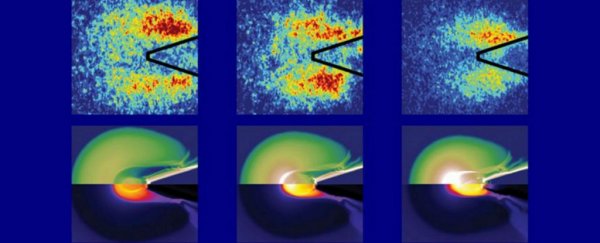For the first time, an international team of scientists has figured out how to visualise energy dispersal in a process known as fast ignition - one of the most promising approaches we have to achieving controlled nuclear fusion.
If we can one day harness the power of nuclear fusion - the process of unleashing vast amounts of energy via high-speed atomic nuclei collisions that fuels our Sun and other stars - we would have access to a safe, clean, and virtually inexhaustible energy source. But scientists have been working on this for more than 60 years, and it's still far from the realm of possibility, thanks to some pretty significant hurdles.
The good news? Significant hurdles haven't stopped the march of scientific advancement in the past, and the handful of research teams around the world that are leading some serious attempts at bringing nuclear fusion reactors to reality are making progress.
Last month, researchers from the Max Planck Institute for Plasma Physics in Germany switched on their mammoth, US$1.1 billion nuclear fusion machine (called a stellarator) after around 1.1 million construction hours, and so far, things are looking pretty promising.
Meanwhile, in the States, a separate team has been working on a different way to achieve controlled nuclear fusion - fast ignition (FI), which initiates nuclear fusion reactions using a high-intensity laser.
The process works in two stages to get the nuclear fusion process going. First off, you need to fire off hundreds of very powerful lasers to compress the fusion fuel, which is usually a mix of deuterium and tritium, to a high density. Next, a single high-intensity laser is used deliver heat energy to the compressed fuel to very rapidly ignite it, which initiates the self-sustaining process of nuclear fusion.
While fast ignition is still very much in the experimental phase, researchers argue that it's a promising avenue towards nuclear fusion because it requires a lot less energy than other potential methods. But one of the big problems with it has been in directing that second-stage laser to hit the densest region of the fuel.
"Before we developed this technique, it was as if we were looking in the dark," said one of the team, Christopher McGuffey from the University of California, San Diego. "Now, we can better understand where energy is being deposited so we can investigate new experimental designs to improve delivery of energy to the fuel."
"This has been a major research challenge since the idea of fast ignition was proposed," added his colleague, Farhat Beg.
All the team had to do was apply simple copper tracers to the spherical plastic fuel capsule. The when they fired the high-intensity laser, they could trace its movement around the capsule because the high-energy electrons it emits hit the tracers and produce visible X-rays.
Publishing in Nature, McGuffey and his colleagues describe how finally being able to visualise where their high-intensity laser is has allowed them to test different ways to improve energy delivery to the fuel target for the first time. According to K. G. Orphanides at Wired UK, the researchers credit this techinque with allowing them to achieve a record high of 7 percent efficiency - "a fourfold improvement on previous fast ignition experiments".
When the experimental design was scaled up, computer models predicted an energy delivery efficiency of up to 15 percent. "Our findings lay the groundwork for further improving efficiency, with 15 percent energy coupling predicted in FI experiments using an existing megajoule-scale laser driver," the team concludes.
When it comes to controlled nuclear fusion, we'll be dealing in baby steps for many years to come, but even tiny developments in the pursuit of something legitimately revolutionary are worth getting excited about. Watch this space.
